A ritual once marked marriage as a spiritual death for women. It’s now a stunning performance
By Giselle Au-Nhien Nguyen, Barney Zwartz and Cameron Woodhead
MUSIC/THEATRE/DANCE
The Bridal Lament 哭嫁歌 ★★★★
Arts House, until May 19
In the culture of Weitou, the earliest settlers of Hong Kong from Southern China, marriage was akin to a kind of spiritual death for women. As a final act of defiance before they were sent off to live with their arranged husbands, the women developed a ritual known as the bridal lament. The woman would go up to a loft for three days, and there, suspended above her world, she would sing songs to her family and friends describing what she was leaving behind.
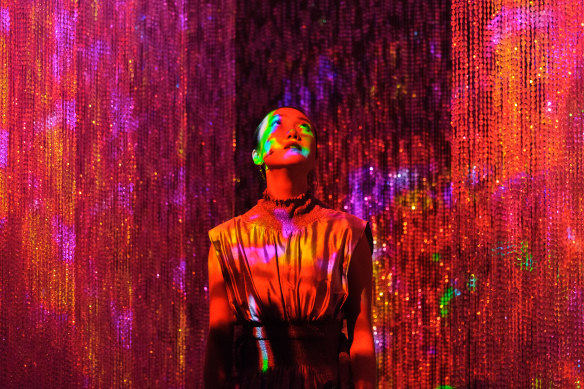
Bridal Lament by Rainbow Chan at Arts House.Credit: Sarah Walker
Multidisciplinary artist and musician Rainbow Chan, whose mother is Weitou, reimagines this world in an ambitious one-woman show, directed by Tessa Leong. Debuting at Sydney’s Liveworks last year before heading to Adelaide’s OzAsia festival, and now playing in Melbourne, The Bridal Lament is a tender, poignant and cinematic vision of Chan’s place between cultures.
The Bridal Lament is many things at once. It has elements of music, both contemporary and ancient, as Chan’s thudding electro-pop melds with traditional Weitou laments in a song cycle form; visual art, with abstract, swirling video projections designed by Rel Pham; and spoken-word, with Chan (and her mother Irene via voiceover in Weitou and Cantonese) narrating the story of the rituals, and the story of their family’s migration to Australia. It is all backdropped by an elaborate beaded archway, animated by dazzling colours.
Chan’s gorgeous voice is the backbone of the show: soft when singing the folksy laments, and furiously commanding on the more modern pop-driven music, where it is sometimes distorted with autotune. The single Seven Sisters is a particular highlight as the archway pulses with colour. Other pieces flirt with ambient styles, adding to the haunting atmosphere. Choreography also plays a part: Chan’s body contorts as she glides across the stage, or writhes on the floor. The language of the laments is translated via video, and it is stunningly poetic, with vivid imagery of fruit and animals illustrating the bride’s plight.
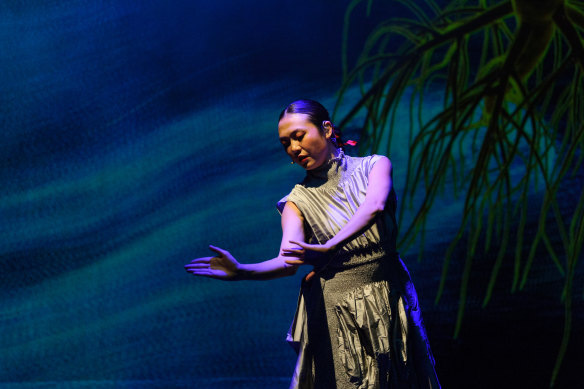
Rainbow ChanCredit: Sarah Walker
The meta-narration is the show’s weakest point, as Chan breaks the fourth wall to speak directly to the audience about what she experienced and learned. While informative, it disrupts the flow of the piece, and jolts the viewer out of the liminal world of the laments.
The Bridal Lament is a rich and layered third-culture meditation on ritual, heritage and loss. When it ends, Chan is in tears. It’s a privilege to go on this emotional journey with her.
Reviewed by Giselle Au-Nhien Nguyen
MUSIC
Jaime Conducts Debussy and Strauss ★★★★
Melbourne Symphony Orchestra, Hamer Hall, May 9
Jaime Martin and the MSO offered a night of high drama – exactly as planned – with two virtuoso works by Claude Debussy and Richard Strauss, plus a rarely played overture.
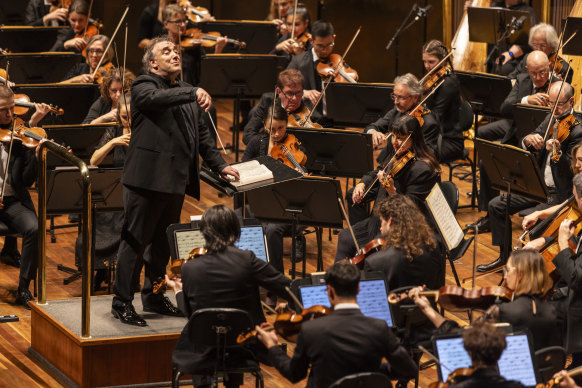
Jaime Martin and the MSO offered a night of high drama.Credit: Mark Gambino
The ambitious program of Debussy’s La Mer (The Sea) and Strauss’s Ein Heldenleben (A Hero’s Life) require on the podium both a fine colourist and a master musical architect, and chief conductor Martin is both. He balanced the shape, line and proportion of each work, energetically combining both the sweep and the detail.
The MSO was augmented by one or two Australian National Academy of Music students in each section, for whom it must have been thrilling to take part in such an explosive concert before a fully appreciative audience.
First came the overture to The Wreckers, an opera about Cornish villagers who lure ships to their doom. By Dame Ethel Smyth, a suffragette whose protests saw her jailed, it was lively and attractive.
A contemporary critic said La Mer should be titled La Mal de Mer (seasickness), while composer Erik Satie said of the movement Dawn to Noon on the Sea that he liked the bit about a quarter to 11. So did I, but I also enjoyed the rest – a subtle and characterful reading.
The highlight was the Strauss, rather immodestly based on the composer’s own life. “I find myself quite as interesting as Napoleon” (the original dedicatee of Beethoven’s Eroica symphony), he said.
Martin opened lickety-split, at the cost of some blurred detail, but built irresistible momentum. This tempo in the second section, “the hero’s enemies” (unsympathetic critics), with carping woodwinds and grumbling bass, made the critics all the more shrill.
Next, “the hero’s companion”, captured Strauss’s wife Pauline in a tender and flirtatious account distinguished by sumptuous playing by associate concertmaster Tair Khisambeev in the challenging extended solo. In summary, a formidable feat of physical fitness and concentration by all involved.
Reviewed by Barney Zwartz
THEATRE
World Problems ★★★
Emma Mary Hall, Melbourne Theatre Company, until May 22
How does knowledge of the global – including catastrophes from nuclear war to climate change – affect our experience at a personal level? How might the smallest corners of our lives be connected, through some butterfly effect, to outcomes much bigger than ourselves?
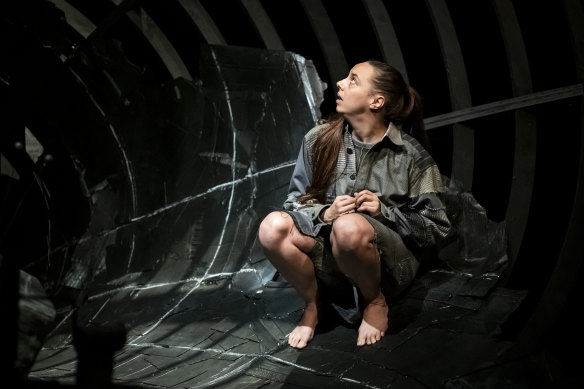
Carly Sheppard’s performance is filled with wry wit.Credit: Tiffany Garvie
World Problems invites the audience to consider such questions, in an hour-long monologue featuring historical disasters and speculative futures, all nestled within the ephemera of childhood memory.
A lone woman (Carly Sheppard) scrambles through what looks like a wrecked fuselage to take the stage. Concrete fragments of recollection build a vivid, culturally precise portrait of growing up as a Gen X queer girl in the Adelaide suburbs, but the dramatic structure is quite poetic and abstract and free-associative, with a universalising impulse.
It reminded me, oddly enough, of the text in Nature Theatre of Oklahoma’s Life and Times – a masterpiece of avant-garde verbatim theatre that used recordings of a woman recalling her childhood in pedestrian detail, complete with “ums” and “ahs” – and it shares the same creative leaps, lacunae, and unbidden thoughts of a person compelled to relate memories in real time.
Sheppard wrestles the chaos of experience into narrative (or the suggestion of it) with wry wit and a coiled presence that embodies the struggle posed by self-reflection. Observations on gender and sexuality are especially sharp, but Sheppard also shows how the character’s personal and social identity are shaped by cultural trends and world events, including all the touchstones of the last generation to grow up without the internet.
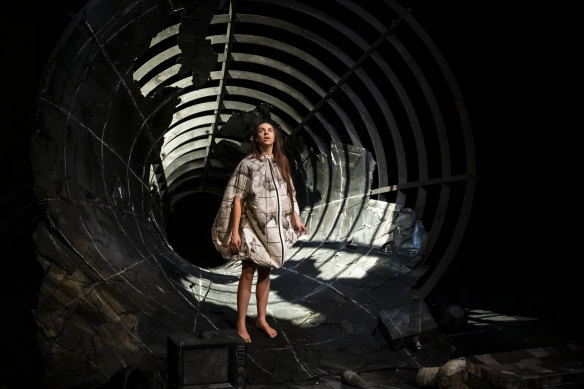
World Problems is an hour-long monologue featuring historical disasters and speculative futures.Credit: Tiffany Garvie
As the woman remembers her young adulthood, middle age, and begins to approach her present, a twist replaces memory with futuristic intimations: apocalyptic dystopias where birds fall out of the sky, or transhuman ones where technology transforms social norms, and people start marrying their own fridges or what have you.
These speculative incursions feel underdeveloped on their own terms.
They will seem more so to theatregoers who saw Sheppard’s previous one-woman show, Chase, about the last First Nations woman left alive on a ruined planet, where a similar, more elaborate dystopian technique was deployed with great success.
Still, the anticlimax doesn’t undermine the integrity of the production, nor does it overshadow the skill or charisma of the central performance, which creates an intimate interior landscape, bristling with all the questions that reflecting on your own story, and how it connects with the bigger picture, can provoke.
Reviewed by Cameron Woodhead
The Booklist is a weekly newsletter for book lovers from books editor Jason Steger. Get it every Friday.